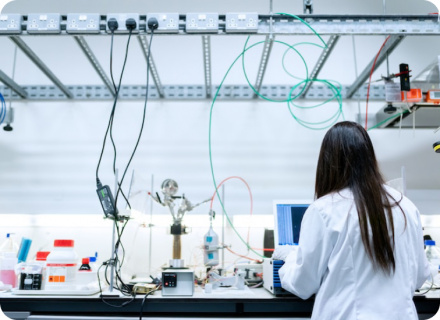A Scalable Strategy for Interrupting Tuberculosis Transmission through Environmental Air Sampling
Sunil Raina1, Matthias Schneider2, Stephane Bilodeau3, Yaneer Bar-Yam4
1 Dr. RP Government Medical College, Tanda (HP), India and World Health Network
2 Medical and Biological Physics, TU Dortmund University and World Health Network
3 Department of Bioengineering, McGill University and World Health Network
4 New England Complex Systems Institute and World Health Network
Abstract
Tuberculosis (TB), particularly in its drug-resistant forms, remains a critical global health challenge. Despite expanded treatment programs, stigma, delayed detection, and gaps in implementation continue to hinder progress toward TB elimination. This paper proposes a scalable, community-based environmental surveillance strategy using low-cost air sampling in shared indoor spaces. By detecting airborne Mycobacterium tuberculosis (Mtb) DNA in high-risk environments, we enable early, stigma-free identification of transmission zones and create new entry points for public health action. This approach complements existing person and environmental testing (such as wastewater testing) diagnostics and offers a rapid, portable and localized intervention model for interrupting TB transmission in diverse settings. Initial deployment will take place in India and expand globally.
1. Introduction
Tuberculosis remains one of the world’s deadliest infectious diseases, with an estimated 10.6 million cases and 1.3 million deaths globally in 2022, including 450,000 drug-resistant TB (DR-TB) cases [1–3]. Drug-resistant TB, in particular, presents a growing biosecurity risk. While access to TB diagnosis and treatment has improved globally, key barriers remain. Surveillance systems do not always detect cases quickly. Social stigma [4-7] discourages some people from being tested. Many people avoid or postpone medical evaluation despite symptoms. Together, these factors allow transmission to continue undetected — especially in crowded indoor environments.
This paper introduces a complementary strategy for TB control: the use of environmental air sampling to detect airborne Mtb DNA in shared spaces such as homes, schools, public transport, and religious gathering sites. The goal is not to replace individual testing, but to identify sites of likely transmission, allowing communities and health systems to act earlier, faster, and without blame. This shifts the focus from who is sick to whether transmission is occurring here, enabling proactive interventions that avoid stigma.
2. Why Environmental Testing?
2.1 The Problem of Stigma
Traditional TB testing requires individuals to self-identify or present with symptoms, which can carry severe social penalties in many communities — including loss of employment, loss of marriage prospects, and housing discrimination. As a result, people delay testing or avoid it entirely. Even where free treatment and food support are available, the perceived cost of diagnosis remains high.
2.2 The Opportunity in Air
TB is primarily an airborne disease [8,9]. Individuals with active pulmonary TB emit aerosolized bacilli that can remain suspended in indoor air for extended periods, especially in poorly ventilated spaces. While person-based diagnostics focus on symptoms and direct detection, air sampling allows us to identify risk before individuals are diagnosed or present for care. It shifts the question from “who is sick” to “is transmission occurring here?”
Environmental detection focuses on identifying transmission zones, creating an avenue for action that does not rely on individual disclosure while offering a shared starting point for community response.
The detection of pathogens in the air is not new [10-13]. The same method can be applied to other airborne pathogens. Special equipment has been developed for air testing, but it is quite costly [14]. Recent studies have shown that the method is robust and off-the-shelf, and DIY construction can be used effectively to perform air testing using fans and filters [15].
3. The Proposed Model
3.1 Device
We use a low-cost, high-airflow air sampler constructed from locally available materials (See Fig. 1):
- 12V fan (or integrated rechargeable unit)
- Kitchen funnel
- PTFE membrane filter (0.3–0.45 μm pore size)
Air is drawn through the funnel through the filter for 1–8 hours in a shared indoor setting. The filter is then removed and sent for DNA-based detection (PCR or LAMP).

3.2 Deployment Sites
Priority spaces include:
- Prayer halls
- Schools
- Large households
- Public transportation (especially long-haul trains, buses, and airplanes)
- Clinics and pharmacies
Sampling occurs passively, without identifying individuals. Positive samples trigger outreach, follow-up testing, treatment, ventilation interventions, or focused awareness efforts.
3.3 Surface Swabbing as Complementary Detection
In addition to air sampling, surfaces in the same environment can be swabbed during the same deployment period. This technique, also supported by recent studies [6], can help identify pathogen deposition and extend the spatial sensitivity of environmental surveillance. Surface swabs can be collected from benches, windowsills, tables, and other exposed areas, and both samples are tested using the same downstream lab protocols (PCR or LAMP). Integrating surface swabbing into field sampling would enhance situational awareness without increasing infrastructure cost.
3.4 Cost and Feasibility
Each unit costs approximately ₹1,500 (~$18 USD), including rechargeable power. Filters are single-use (~₹200 each). The device is hand-carried, battery-powered, and requires only simple mechanical assembly. All components are locally available in India. The airflow of these units (~850–1400 L/min, based upon fan specification) is comparable to or exceeds that of specially developed commercial devices, including models costing 300× more.
4. Pilot Sites and Initial Implementation
This initiative will begin in India, where national programs already support strong TB surveillance and where drug-resistant TB remains a priority challenge. India accounts for ~28% of global TB cases and benefits from an established national TB program, a broad laboratory network, and an extensive community health worker infrastructure. Project partners include public health leaders, physicians, and community organizers.
Initial pilot sites will include locations of extended occupancy, including prayer spaces (high occupancy) and schools (protection of children). We are finalizing device validation, testing lab protocols, and deployment workflows. Sampling will begin in these settings, coordinated with community health workers and local clinics, and will include training health workers, validating capture efficiency, and establishing data-to-action protocols.
5. Impact Potential
Environmental testing complements existing strategies by:
- Bypassing stigma and enabling proactive detection
- Identifying hotspots for airborne transmission
- Supporting community-level prevention measures
- Providing visible, actionable feedback for system response
The approach may also generalize to other airborne pathogens (e.g. COVID-19, influenza), expanding its utility as a tool for global respiratory disease control, including current and future zoonotic outbreaks.
6. Next Steps and Collaboration Invitation
We are seeking partners in:
- Lab testing and diagnostic analysis
- Field deployment and logistics
- Community engagement
- Global coordination and scaling
This project is an opportunity to demonstrate how targeted, systems-aware implementation can unlock progress where conventional approaches stall. This project is not only an intervention — it is a test case for how rapid, systems-based solutions can be scaled globally. We invite collaborators from science, policy, design, public health, and civil society to join us.
Acknowledgement: This paper was developed through the Unpolitics working group network.
References
- World Health Organization. (2024). Global tuberculosis report 2024. Geneva: World Health Organization. https://iris.who.int/bitstream/handle/10665/379339/9789240101531-eng.pdf
- Zignol, M., Dean, A. S., Falzon, D., van Gemert, W., Wright, A., van Deun, A., … Floyd, K. (2016). Twenty years of global surveillance of antituberculosis-drug resistance. New England Journal of Medicine, 375(11), 1081–1089. https://doi.org/10.1056/NEJMsr1512438
- Floyd, K., Glaziou, P., Zumla, A., & Raviglione, M. (2018). The global tuberculosis epidemic and progress in care, prevention, and research: An overview in year 3 of the End TB era. The Lancet Respiratory Medicine, 6(4), 299–314. https://doi.org/10.1016/S2213-2600(18)30057-2
- Mukerji, R., & Turan, J. M. (2018). Exploring manifestations of TB-related stigma experienced by women in Kolkata, India. Annals of Global Health, 84(4), 727–735. https://doi.org/10.29024/aogh.2383
- Thomas, B. E., & Stephen, A. (2020). Tuberculosis related stigma in India: Roadblocks and the way forward. Expert Review of Respiratory Medicine, 15(7), 859–861. https://doi.org/10.1080/17476348.2020.1826314
- Kamble, B. D., Singh, S. K., Jethani, S., Chellaiyan, V. G. D., & Acharya, B. P. (2020). Social stigma among tuberculosis patients attending DOTS centers in Delhi. Journal of Family Medicine and Primary Care, 9(8), 4223–4228. https://doi.org/10.4103/jfmpc.jfmpc_709_20
- Ali, M. A., Gupta, V., Addanki, R. N. D., Mannava, A. S., & Parashar, K. D. (2024). A cross-sectional study to assess stigma associated with tuberculosis in patients, family members, and health care staff in central India. Indian Journal of Tuberculosis, 71(Suppl 2), S237–S244. https://doi.org/10.1016/j.ijtb.2024.04.001
- Fennelly, K. P., & Jones-López, E. C. (2015). Quantity and quality of inhaled dose predicts immunopathology in tuberculosis. Frontiers in Immunology, 6, 313. https://doi.org/10.3389/fimmu.2015.00313
- Bussi, C., & Gutierrez, M. G. (2019). Mycobacterium tuberculosis infection of host cells in space and time. FEMS Microbiology Reviews, 43(4), 341–361. https://doi.org/10.1093/femsre/fuz006
- Chen, P.-S., & Li, C.-S. (2005). Quantification of airborne Mycobacterium tuberculosis in health care setting using real-time qPCR coupled to an air-sampling filter method. Aerosol Science and Technology, 39(4), 371–376. https://doi.org/10.1080/027868290945767
- Chen, P.-S., & Li, C.-S. (2008). Concentration profiles of airborne Mycobacterium tuberculosis in a hospital. Aerosol Science and Technology, 42(3), 194–200. https://doi.org/10.1080/02786820801922953
- Middelkoop, K., Koch, A. S., Hoosen, Z., Bryden, W., Call, C., Seldon, R., Warner, D. F., Wood, R., & Andrews, J. R. (2023). Environmental air sampling for detection and quantification of Mycobacterium tuberculosis in clinical settings: Proof of concept. Infection Control & Hospital Epidemiology, 44(5), 774–779. https://doi.org/10.1017/ice.2022.162
- Kamariza, M., & Karp, C. L. (2021). Air sampling for Mycobacterium tuberculosis detection: A review of the literature and implications for new technologies. Respiratory and Critical Care Medicine, 204(4), 430–439. https://doi.org/10.1164/rccm.202102-0405OC
- Thermo Fisher Scientific. (2025). AerosolSense™ Sampler – Bioaerosol Pathogen Detection Device (Model 2900AA). Fisher Scientific. Retrieved from https://www.fishersci.com/shop/products/aerosolsense-airborne-pathogen-detection-solution/2900AA
- Simaitis, A., Daniunaite, K., Brunsch, V., Danzer, J., Rosenstein, T., Bar-Yam, Y., Trosky, T., & Schneider, M. F.(2025). Water, air and surfaces testing: Efficient surveillance at high speed and low burden for the society (preprint, in preparation). Medical and Biological Physics, TU Dortmund; New England Complex Systems Institute; World Health Network


